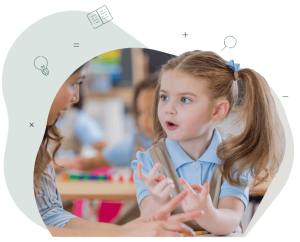6 The teacher’s role in play-based learning approaches
All theories demonstrate that play holds value in a student’s learning. However, more recent research highlights the importance of teachers’ interaction with students (Robertson, Yim & Paatsch, 2020). Teacher’s interactions have the potential to maximise the learning potentials of play experiences. Play-based learning is much more than setting up a classroom with play resources and then standing back to let students play. Teachers must engage with students to scaffold and support their learning during play.

How does the teacher facilitate student’s learning through play?
A play-based approach involves both student-initiated and teacher-supported learning. Student initiated learning is where the student selects and guides their own learning within a play experience. Teacher supported learning takes place when students are provided with guidance from teachers in their play through interactions that extend on learning concepts, capabilities, and skills. For example, while students are playing with blocks, a teacher can pose questions that encourage problem solving, prediction, and hypothesising. The teacher can also bring the student’s awareness towards mathematics, science and literacy concepts, allowing them to engage with such concepts through hands-on learning and discipline-specific language. Both student-initiated and teacher-supported learning have an important role in play-based classrooms. This concept is explored further in Robertson, Morrissey, and Rouse’s (2018) article, ‘Play-based learning can set your child up for success at school and beyond’.
Read, look or listen
As this interactive textbook recurrently states, it’s essential to remember that teachers have a critical role in children’s play experiences. The teacher’s role in supporting play-based learning is more active and complex than providing play resources and then standing back to let children play. Teachers must flexibly adjust their role as children move through different phases of play and inquiry.
Engage and extend
The interactive diagram below illustrates how learning can be facilitated through student-initiated and teacher-supported learning. Click on the plus (+) icons to see the intersections between the two types of play-based teaching and reflect on times when one type of teaching may be more beneficial than the other.
Open text versionClose text version

Teacher’s role in play-based learning approaches
Hotspot 1: Guided play and learning
Refers to a teacher’s involvement in student’s play and learning by ‘responding to spontaneous learning opportunities as they arise’ (VEYLDF, 2016, p. 15). This may include the use of open-ended questions and in-depth conversations, the co-construction of knowledge by problem solving together, and the provision of resources and materials to prompt further learning through play.
Hotspot 2: Child-directed play and learning
Defined as ‘an exploratory process that occurs when children lead their learning through exploring, imagining, experimenting, investigating, and being creative in ways that they control’ (VEYLDF, 2016, p. 15). In a school context, the teacher’s role in child-directed play and learning may be through their observations, assessment, and analysis of what the student has drawn, written, constructed, and/or spoken about. Teachers use this information to extend students’ learning in later learning sequences through adult-led learning. Teachers also support child-directed play and learning through the management of space, time, and resources. Teachers’ interactions support and extend play.
Hotspot 3: Adult-led learning
Adult-led learning occurs when teachers introduce a concept, topic, or idea for exploration. Explicit teaching of concepts, topics, and/or ideas are made possible through play-based teaching strategies and resources. While students have agency in this pedagogical approach, students’ experiences and inquiries are primarily planned for by teachers. Teachers’ plans are based on their understanding of students’ current interests and prior knowledges.

